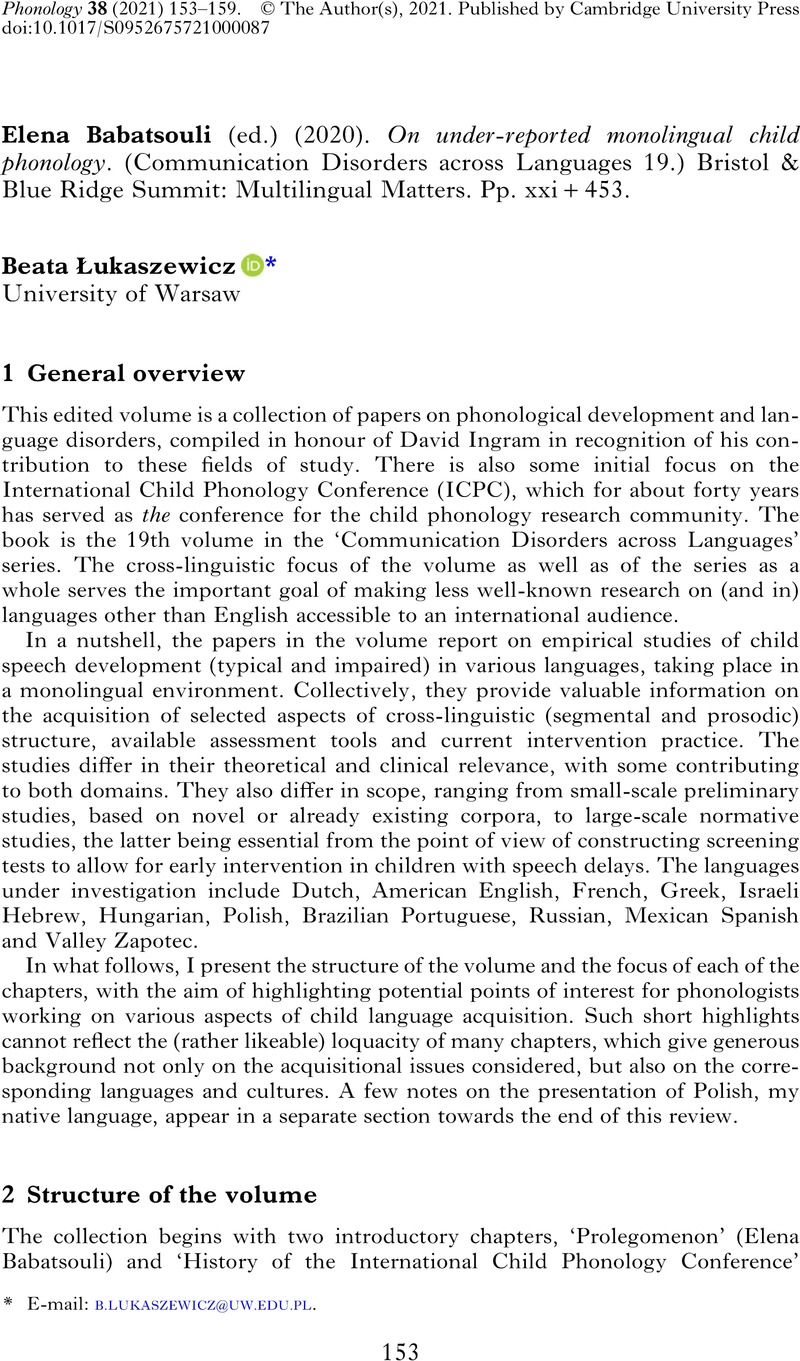No CrossRef data available.
Article contents
Elena Babatsouli (ed.) (2020). On under-reported monolingual child phonology. (Communication Disorders across Languages 19.) Bristol & Blue Ridge Summit: Multilingual Matters. Pp. xxi + 453.
Review products
Elena Babatsouli (ed.) (2020). On under-reported monolingual child phonology. (Communication Disorders across Languages 19.) Bristol & Blue Ridge Summit: Multilingual Matters. Pp. xxi + 453.
Published online by Cambridge University Press: 02 July 2021
Abstract
An abstract is not available for this content so a preview has been provided. Please use the Get access link above for information on how to access this content.

- Type
- Review
- Information
- Copyright
- Copyright © The Author(s), 2021. Published by Cambridge University Press
References
Anderson, Stephen R. (1985). Phonology in the twentieth century: theories of rules and theories of representations. Chicago: University of Chicago Press.Google Scholar
Baudouin de Courtenay, Jan (1974). Spostrzeżenia nad językiem dziecka. Edited by Chmura-Klekotowa, Maria. Wrocław: Zakład Narodowy im. Ossolińskich.Google Scholar
Bernhardt, Barbara H. & Stemberger, Joseph P. (1998). Handbook of phonological development from the perspective of constraint-based nonlinear phonology. San Diego: Academic Press.Google Scholar
Bryndal, Małgorzata (2015). Fonologiczna interpretacja procesów doskonalenia wymowy dziecięcej na tle współczesnych teorii fonologicznych. Gliwice: Komlogo.Google Scholar
Bybee, Joan (2007). Frequency of use and the organization of language. Oxford: Oxford University Press.CrossRefGoogle Scholar
Chomsky, Noam & Halle, Morris (1968). The sound pattern of English. New York: Harper & Row.Google Scholar
de Jong, Kenneth J. (1995). The supraglottal articulation of prominence in English: linguistic stress as localized hyperarticulation. JASA 97. 491–504.CrossRefGoogle ScholarPubMed
Dziubalska-Kołaczyk, Katarzyna (2014). Explaining phonotactics using NAD. Language Sciences 46. 6–17.CrossRefGoogle Scholar
Ferguson, Charles A. & Farwell, Carol B. (1975). Words and sounds in early language acquisition. Lg 51. 419–439.Google Scholar
Gouskova, Maria (2013). Review of Marc van Oostendorp, Colin J. Ewen, Elizabeth Hume & Keren Rice (eds.) (2011). The Blackwell companion to phonology. Malden, MA: Wiley-Blackwell. Phonology 30. 173–179.Google Scholar
Gussenhoven, Carlos (2002). Intonation and interpretation: phonetics and phonology. In Bel, Bernard & Marlien, Isabelle (eds.) Speech prosody 2002. Aix-en-Provence. 47–57. Available (January 2021) at http://www.isca-speech.org/archive/sp2002.CrossRefGoogle Scholar
Ingram, David (1974a). Phonological rules in young children. Journal of Child Language 1. 49–64.CrossRefGoogle Scholar
Ingram, David (1974b). Fronting in child phonology. Journal of Child Language 1. 233–241.CrossRefGoogle Scholar
Ingram, David (1975). Surface contrast in children's speech. Journal of Child Language 2. 287–292.CrossRefGoogle Scholar
Ingram, David (1988). Jakobson revisited: some evidence from the acquisition of Polish. Lingua 75. 55–82.CrossRefGoogle Scholar
Jakobson, Roman (1941). Kindersprache, Aphasie, und allgemeine Lautgesetze. Mouton: The Hague.Google Scholar
Jarosz, Gaja (2017). Defying the stimulus: acquisition of complex onsets in Polish. Phonology 34. 269–298.CrossRefGoogle Scholar
Ladefoged, Peter & Maddieson, Ian (1996). The sounds of the world's languages. Oxford & Malden, MA: Blackwell.Google Scholar
Lorenc, Anita (2018). Articulatory characteristics of Polish retroflex sibilants: analysis using electromagnetic articulography. Logopedia 47. 103–121.Google Scholar
Łukaszewicz, Beata (2000). Phonological analysis of reduction and assimilation processes in the acquisition of English and Polish. PhD dissertation, University of Warsaw.Google Scholar
Łukaszewicz, Beata (2006). Extrasyllabicity, transparency and prosodic constituency in the acquisition of Polish. Lingua 116. 1–30.CrossRefGoogle Scholar
Łukaszewicz, Beata (2007). Reduction in syllable onsets in the acquisition of Polish: deletion, coalescence, metathesis, and gemination. Journal of Child Language 34. 53–82.CrossRefGoogle ScholarPubMed
Pierrehumbert, Janet B. (2001). Exemplar dynamics: word frequency, lenition and contrast. In Bybee, Joan & Hopper, Paul (eds.) Frequency and the emergence of linguistic structure. Amsterdam & Philadelphia: Benjamins. 137–157.CrossRefGoogle Scholar
Shinn, Milicent Washburn (1900). The biography of a baby. Boston & New York: Houghton, Mifflin & Co.Google Scholar
Szuman, Stefan (1955). Rozwój treści słownika dzieci (zagadnienie i niektóre wyniki badań). Studia Pedagogiczne 2. 5–74.Google Scholar
Tomasello, Michael (2003). Constructing a language: a usage-based theory of language acquisition. Cambridge, MA: Harvard University Press.Google Scholar
Trubetzkoy, Nikolai S. (1939). Grundzüge der Phonologie. Göttingen: van der Hoeck & Ruprecht.Google Scholar
Weist, Richard M. & Witkowska-Stadnik, Katarzyna (1986). Basic relations in child language and the word order myth. International Journal of Psychology 21. 363–381.CrossRefGoogle Scholar
Zarębina, Maria (1965). Kształtowanie się systemu językowego dziecka. Wrocław: Zakład Narodowy im. Ossolińskich.Google Scholar





